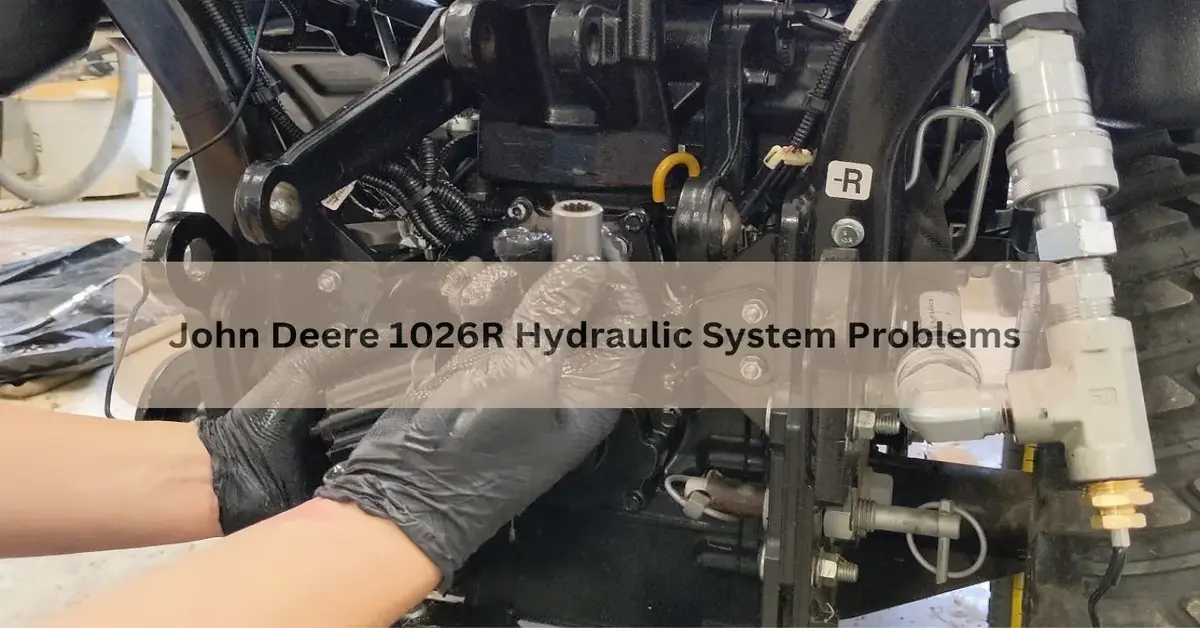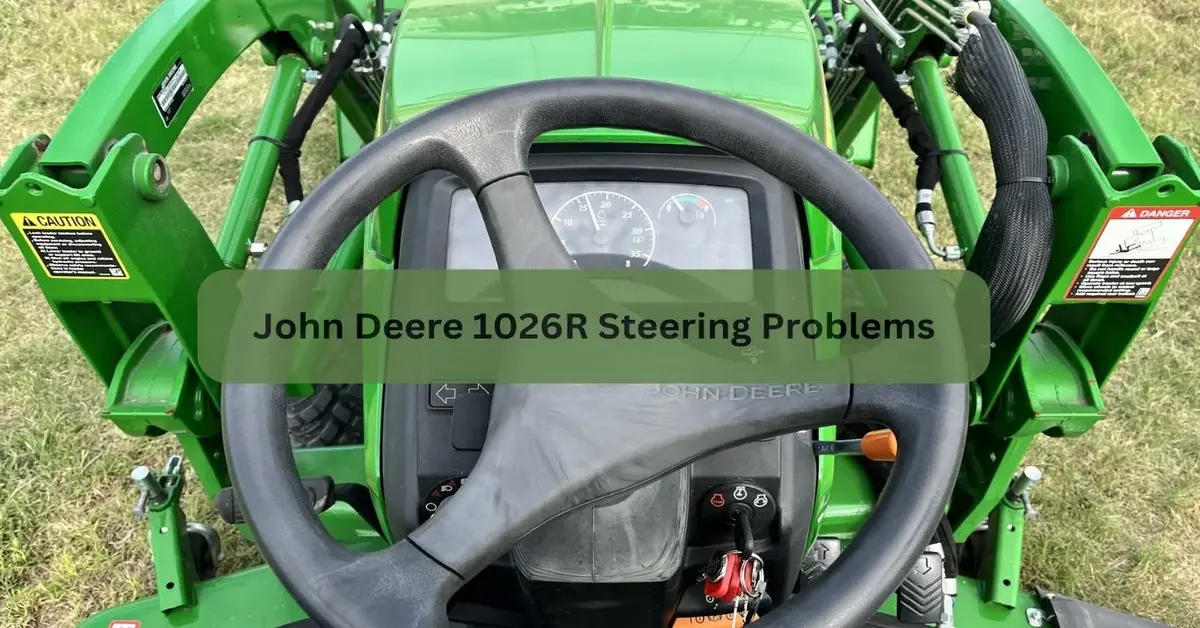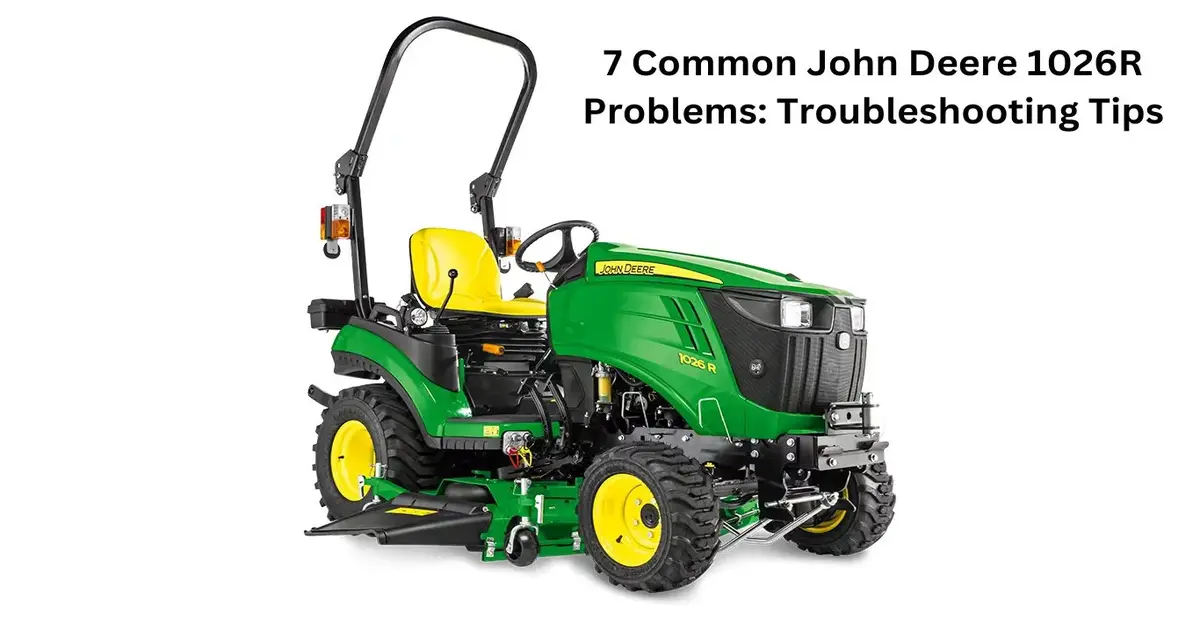The John Deere 1026R is a popular compact utility tractor known for its versatility and reliability. With its compact size and powerful performance, it’s a favorite among homeowners, landscapers, and small farm operators alike. Equipped with a range of attachments and features, the 1026R is designed to tackle various tasks, from mowing and tilling to hauling and snow removal.
Importance of Troubleshooting Common Issues for Smooth Operation
Maintaining the optimal performance of your John Deere 1026R is essential for maximizing productivity and efficiency. However, like any mechanical equipment, the 1026R may encounter problems from time to time. Addressing these issues promptly can prevent further damage and costly repairs. By troubleshooting common problems, you can ensure that your tractor operates smoothly and reliably, allowing you to get the job done with confidence.
Purpose of the Blog: to Identify and Address Seven Common Problems
The purpose of this blog is to help John Deere 1026R owners identify and troubleshoot common issues that may arise during operation. By providing detailed insights and practical tips, we aim to empower tractor owners to tackle problems effectively and keep their equipment running smoothly. From starting issues to hydraulic malfunctions, we’ll cover seven common problems and offer practical troubleshooting tips to resolve them. Let’s dive in!
Problem 1: Starting Issues
Symptoms: Difficulty starting the tractor
Sometimes, when you’re all set to start your John Deere 1026R, you may encounter a problem: it won’t start. This can be frustrating, especially when you have important tasks to complete on your land. When you turn the key, but the engine doesn’t respond, it’s a clear sign of a starting issue.
Potential Causes: Battery, Fuel System, or Ignition Problems
Several things could be causing your John Deere 1026R to have trouble starting. One common culprit is the battery. If the battery is weak or not properly connected, it can prevent the engine from turning over. Another potential cause could be related to the fuel system. If there’s not enough fuel or if the fuel quality is poor, it can hinder the engine’s ability to start. Additionally, issues with the ignition system, such as faulty spark plugs or a malfunctioning ignition switch, can also contribute to starting problems.
Troubleshooting Tips
To get to the bottom of your starting issue and get your John Deere 1026R up and running again, here are some troubleshooting tips to try:
-
Check Battery Connections: Start by inspecting the battery connections. Make sure they are tight and free of corrosion. If you notice any corrosion, clean the connections thoroughly with a wire brush and some baking soda mixed with water.
-
Verify Fuel Levels and Fuel Quality: Next, check the fuel levels in your tractor’s tank. If it’s low, fill it up with fresh, clean fuel. Additionally, consider the quality of the fuel you’re using. If it’s been sitting for a while or if it’s contaminated, it could be causing starting issues. In such cases, it’s best to drain the fuel tank and refill it with fresh fuel.
-
Inspect Ignition System Components: Lastly, inspect the ignition system components for any signs of wear or damage. Check the spark plugs, ignition coil, and ignition switch for any visible issues. If you notice any problems, such as worn-out spark plugs or a damaged ignition switch, replace them as needed.
Read More: John Deere MX7 Problems and How To Fix Them?
Problem 2: Engine Overheating
Symptoms: Engine Temperature Gauge in the Red Zone
When you’re out working hard on your land with your John Deere 1026R, one problem you definitely want to avoid is engine overheating. If you notice the engine temperature gauge creeping into the red zone, it’s a clear indication that your tractor’s engine is running hotter than it should be.
Potential Causes: Cooling System Issues, Low Coolant Levels
There are a few potential culprits behind your John Deere 1026R’s engine overheating. One common cause is cooling system issues. This could include things like a malfunctioning radiator, a stuck thermostat, or clogged coolant hoses. Another possible reason for overheating could be low coolant levels. If there isn’t enough coolant in the system to properly regulate the engine temperature, it can lead to overheating issues.
Troubleshooting Tips
To address engine overheating in your John Deere 1026R, here are some troubleshooting tips to consider:
-
Inspect Radiator and Coolant Hoses for Leaks: Start by inspecting the radiator and coolant hoses for any signs of leaks or damage. Look for wet spots or visible cracks in the hoses, and check the radiator for any corrosion or punctures. If you find any leaks or damage, repair or replace the affected components as needed.
-
Ensure Proper Coolant Level and Quality: Next, check the coolant level in your tractor’s radiator. If it’s low, top it up with the appropriate coolant mixture recommended by John Deere. Additionally, make sure the coolant you’re using is clean and free of debris or contaminants. If the coolant is old or dirty, flush the system and refill it with fresh coolant.
-
Clean Debris from Radiator Fins: Over time, dirt, leaves, and other debris can accumulate on the radiator fins, restricting airflow and causing the engine to overheat. Periodically, inspect the radiator fins and carefully clean them using a soft brush or compressed air to remove any buildup.
Read More: John Deere MX10 Problems and How to Fix Guide


Problem 3: Hydraulic System Malfunction
Symptoms: Loss of Hydraulic Power, Slow Implement Operation
When you’re using your John Deere 1026R with hydraulic attachments, such as a loader or backhoe, you expect smooth and responsive operation. However, if you notice a loss of hydraulic power or sluggish implement operation, it’s a sign that your tractor’s hydraulic system may be malfunctioning.
Potential Causes: Low Hydraulic Fluid, Damaged Hoses or Seals
Several factors could be contributing to the hydraulic system malfunction on your John Deere 1026R. One common issue is low hydraulic fluid levels. If there isn’t enough fluid in the system, it can’t generate the necessary pressure to power the hydraulic implements effectively. Additionally, damaged hoses or seals can lead to hydraulic leaks, causing a loss of pressure and reduced performance.
Troubleshooting Tips
To address hydraulic system malfunctions on your John Deere 1026R, here are some troubleshooting tips to follow:
-
Check Hydraulic Fluid Level and Condition: Start by checking the hydraulic fluid level in your tractor’s reservoir. If it’s low, top it up with the appropriate hydraulic fluid recommended by John Deere. Additionally, inspect the condition of the fluid. If it appears dirty or contaminated, it may be necessary to drain and replace it with fresh fluid.
-
Inspect Hoses and Connections for Leaks: Next, visually inspect all hydraulic hoses and connections for signs of leaks or damage. Look for wet spots, drips, or visible cracks in the hoses, and check the connections for any loose fittings. If you find any leaks or damaged components, repair or replace them as needed to prevent further fluid loss.
-
Replace Damaged Seals or Components as Needed: Finally, if you suspect that damaged seals or components are causing the hydraulic system malfunction, it’s essential to address these issues promptly. Inspect all hydraulic cylinders, valves, and other components for signs of wear or damage, and replace any faulty seals or components to restore proper hydraulic function.
Read More: John Deere Differential Lock Problems and How To Fix It?
Problem 4: Transmission Issues
Symptoms: Difficulty Shifting Gears, Unusual Noises
When operating your John Deere 1026R, encountering difficulty shifting gears or hearing unusual noises can be indications of transmission issues. You might find it hard to move between gears or hear grinding or whining noises coming from the transmission.
Potential Causes: Low Transmission Fluid, Worn Clutch Components
Transmission problems in your John Deere 1026R could stem from various issues. One possible cause is low transmission fluid levels. If the fluid is insufficient, it can impede smooth gear shifting and cause excessive wear on transmission components. Additionally, worn clutch components, such as the clutch disk or pressure plate, can lead to difficulty in engaging gears.
Troubleshooting Tips
To troubleshoot transmission issues with your John Deere 1026R, consider the following tips:
-
Check Transmission Fluid Level and Condition: Begin by inspecting the transmission fluid level and its condition. Ensure that the fluid is at the appropriate level according to the manufacturer’s specifications. Additionally, check the fluid’s color and consistency. If it appears dark or has a burnt odor, it may indicate the need for a fluid change.
-
Inspect Clutch Linkage and Adjust If Necessary: Next, examine the clutch linkage for any signs of wear or misalignment. Ensure that the clutch pedal has proper free play and adjusts the linkage if necessary to achieve the correct pedal height and engagement point.
-
Look for Signs of Wear on Transmission Components: Finally, visually inspect the transmission components for any signs of wear or damage. Check for worn gear teeth, damaged synchro rings, or leaking seals. Replace any worn or damaged parts as needed to restore proper transmission function.
Read More: Common John Deere 6068 Engine Problems and Solutions
Problem 5: Electrical Problems
Symptoms: Electrical System Failures, Malfunctioning Lights or Gauges
When you’re working with your John Deere 1026R, encountering electrical problems can be frustrating. You might experience failures in the electrical system, such as issues with starting the tractor or malfunctioning lights and gauges on the dashboard.
Potential Causes: Faulty Wiring, Blown Fuses, or Malfunctioning Components
Electrical problems in your John Deere 1026R can arise from various sources. One possible cause is faulty wiring, where damaged or corroded wires can disrupt the flow of electricity. Another common culprit is blown fuses, which can occur due to electrical overload or short circuits. Additionally, malfunctioning components such as the starter motor or alternator can also lead to electrical issues.
Troubleshooting Tips
To troubleshoot electrical problems with your John Deere 1026R, consider the following tips:
-
Inspect Wiring Harness for Damage or Loose Connections: Start by visually inspecting the wiring harness for any signs of damage or loose connections. Look for frayed wires, corrosion, or disconnected plugs. Repair or replace any damaged wiring and ensure all connections are secure.
-
Test and Replace Blown Fuses: Check the fuse box of your tractor for any blown fuses. Use a fuse tester or visually inspect the fuses for signs of damage, such as a broken filament. Replace any blown fuses with new ones of the same amperage rating to restore electrical function.
-
Use a Multimeter to Diagnose Electrical Component Issues: If you’re still experiencing electrical problems after checking the wiring and fuses, use a multimeter to diagnose issues with specific electrical components. Test the continuity of switches, relays, and other components to identify any faulty parts that may need replacement.
Read More: John Deere 4830 Sprayer Problems: Causes and Solutions
Problem 6: PTO (Power Take-Off) Malfunction
Symptoms: PTO Not Engaging or Disengaging Properly
When you’re using the Power Take-Off (PTO) on your John Deere 1026R, you expect it to engage and disengage smoothly. However, if you’re experiencing difficulty with the PTO not engaging or disengaging properly, it can hinder your ability to operate attachments such as mowers, tillers, or rotary brushes.
Potential Causes: PTO Clutch Issues, Hydraulic Problems
Several factors could contribute to PTO malfunctions in your John Deere 1026R. One possible cause is problems with the PTO clutch. If the clutch isn’t adjusted correctly or if it’s worn out, it can prevent proper engagement or disengagement of the PTO. Additionally, hydraulic issues, such as low hydraulic pressure or leaks in the hydraulic system, can also affect PTO operation.
Troubleshooting Tips
To troubleshoot PTO malfunctions on your John Deere 1026R, consider the following tips:
-
Check PTO Clutch Adjustment and Condition: Begin by inspecting the adjustment and condition of the PTO clutch. Ensure that the clutch is properly adjusted according to the manufacturer’s specifications and that there is no excessive wear or damage. If necessary, adjust or replace the clutch to restore proper PTO operation.
-
Verify Proper Hydraulic Pressure to PTO System: Next, check the hydraulic pressure to the PTO system. Inspect the hydraulic lines, fittings, and connections for any signs of leaks or damage. Verify that the hydraulic pump is supplying adequate pressure to the PTO system. If not, address any hydraulic issues to restore proper PTO functionality.
-
Inspect PTO Engagement Linkage for Damage: Finally, visually inspect the PTO engagement linkage for any signs of damage or wear. Look for bent or broken linkage components and ensure that all connections are secure. Replace any damaged parts and lubricate the linkage as needed to facilitate the smooth operation of the PTO.
Read More: John Deere 4200 Hydraulic Problems: How to Fix It?

Problem 7: Steering Problems
Symptoms: Difficulty Steering, Uneven Turning
When you’re maneuvering your John Deere 1026R, encountering difficulty in steering or noticing uneven turning can be indicators of steering problems. You might find it challenging to turn the steering wheel, or the tractor may not respond smoothly when turning.
Potential Causes: Low Hydraulic Fluid, Worn Steering Components
Steering issues in your John Deere 1026R can stem from various causes. One possible reason is low hydraulic fluid levels in the steering system. Insufficient fluid can lead to difficulty in steering as the hydraulic power assist may not function correctly. Additionally, worn steering components, such as tie rods, ball joints, or steering gear, can contribute to steering problems.
Troubleshooting Tips
To troubleshoot steering problems with your John Deere 1026R, consider the following tips:
-
Check Hydraulic Fluid Level and Quality: Begin by checking the hydraulic fluid level in the tractor’s steering system reservoir. Ensure that the fluid is at the appropriate level and of good quality. If the fluid is low or dirty, top it up or replace it with fresh fluid as recommended by the manufacturer.
-
Inspect Steering Linkage for Wear or Damage: Next, visually inspect the steering linkage for any signs of wear or damage. Check the tie rods, ball joints, and steering gear for excessive play, rust, or corrosion. Replace any worn or damaged components to restore proper steering function.
-
Lubricate Steering Components as Recommended by the Manufacturer: Finally, lubricate the steering components according to the manufacturer’s recommendations. Apply grease to the tie rod ends, ball joints, and other moving parts to ensure smooth operation and reduce wear and tear on the steering system.
Read More: John Deere 348 Baler Problems – How To Fix
Conclusion
In conclusion, owning a John Deere 1026R compact utility tractor can be a valuable asset for your land management tasks. However, like any equipment, it may encounter common problems that require troubleshooting. By identifying the symptoms and potential causes of these issues, you can take proactive steps to address them effectively.
From starting problems to steering issues, understanding the troubleshooting tips provided in this guide can help you maintain the optimal performance of your John Deere 1026R. Regular maintenance, such as checking fluid levels, inspecting components for wear, and following manufacturer recommendations for lubrication, is essential for preventing problems and ensuring smooth operation.
Remember, if you encounter persistent issues or are unsure how to proceed with troubleshooting, don’t hesitate to seek assistance from a qualified technician or John Deere service center. With proper care and attention, you can keep your John Deere 1026R running smoothly for years to come.

i have a 1026 that will not start. lights will not work. i played with the keys and dash lights came on for a second , turn on flasher did not work but blink on dash what can i try to fix
Hi there,
I’m sorry to hear that you’re experiencing issues with your John Deere 1026R not starting and the lights not working properly. It can be frustrating when your equipment doesn’t cooperate, but let’s see if we can troubleshoot the problem together.
First, let’s address the issue of the lights not working and the dash lights coming on briefly. This could potentially be related to a loose or corroded electrical connection. Here are some steps you can try:
Check the Battery: Make sure the battery is properly connected and fully charged. A weak or dead battery can cause electrical issues.
Inspect the Wiring: Look for any loose or damaged wires in the electrical system. Pay special attention to the connections around the battery and the fuse box.
Clean Connections: If you find corrosion on the battery terminals or other connections, clean them with a wire brush and apply some battery terminal grease to prevent further corrosion.
Check Fuses and Relays: Inspect the fuses and relays in the fuse box to ensure they are not blown or damaged. Replace any that are faulty.
Key Switch: Since you mentioned playing with the keys, there might be an issue with the ignition switch. Ensure that the key is turning smoothly, and the switch is making a solid connection.
Grounding: Ensure that all ground connections are secure and clean. Poor grounding can cause electrical issues.
Regarding the issue with the flasher not working but a blink on the dash, it may be an indicator of a fault code. John Deere tractors are equipped with diagnostic features that can provide information about the problem. Consult your tractor’s manual or contact your local John Deere dealer for guidance on retrieving and interpreting fault codes.
If you’ve tried these steps and the issue persists, it might be a more complex electrical problem, and it could be beneficial to seek the assistance of a professional technician who specializes in John Deere equipment. They will have the necessary tools and expertise to diagnose and repair the issue.
I hope these suggestions help you get your John Deere 1026R back up and running smoothly. If you have any more questions or need further assistance, please don’t hesitate to ask. We’re here to help!
Best regards,
Jerry